|
Staff Newsletter | Minnesota Department of Natural Resources |
|
|
July 21, 2023
In This Issue
|
|
DNR, Minnesota Zoo reintroduce Dakota skipper butterflies to Glacial Lakes State Park
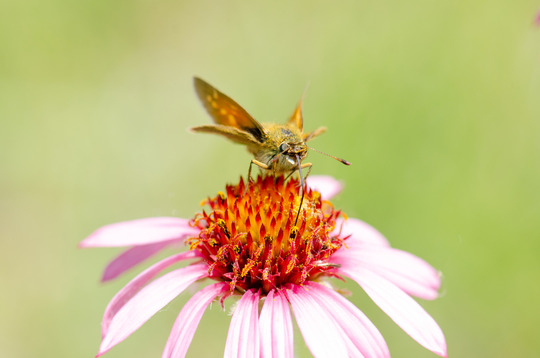 A Dakota skipper feeds on nectar at Glacial Lakes State Park. Access to nectar is critical for Dakota skipper survival, and the species relies heavily on the narrow-leaved purple coneflower. Photo credit: Deb Rose
By Kristi Coughlon, regional information officer
The Minnesota Department of Natural Resources and the Minnesota Zoo recently released hundreds of Dakota skipper butterflies in the prairie at Glacial Lakes State Park.
Once common throughout much of Minnesota's native tallgrass prairie, including the prairie at Glacial Lakes, Dakota skippers have since vanished from nearly all sites in the state. The Dakota skipper can only survive in native prairie habitat. Today, approximately 1% of native prairie remains in the state. It is listed as an endangered species in Minnesota, and threatened in the U.S.
The Minnesota Zoo, the Minnesota DNR's Parks and Trails Division, the U.S. Fish and Wildlife Service and the Nature Conservancy developed a unique conservation research partnership to help save the Dakota skipper and other Minnesota endangered prairie butterflies.
A Parks and Trails resource crew, led by Parks and Trails Northwest Regional Resources Management Supervisor Cindy Lueth, has been enhancing remnant native prairie sites at Glacial Lakes State Park for the reintroduction effort since 2018. Park staff harvested and planted seed from native prairie vegetation and hand-planted thousands of narrow-leaved purple coneflower, the preferred nectar source for the skipper. The crew removed more than 250 acres of woody vegetation, conducted prescribed burns, and has now introduced grazing as one of the tools to manage the prairie habitat for the butterfly.
The Minnesota Zoo's Pollinator Conservation Initiative created the world's first rearing and breeding program for the Dakota skipper and Poweshiek skipperling in 2012 to help save those species from extinction. The zoo rears hundreds of skippers annually in its facility, then releases and monitors those individuals to help re-establish lost populations. Zoo biologists also study wild populations of prairie butterflies and their habitats to assess their status and the threats they face. Get more information in a video about the reintroduction.
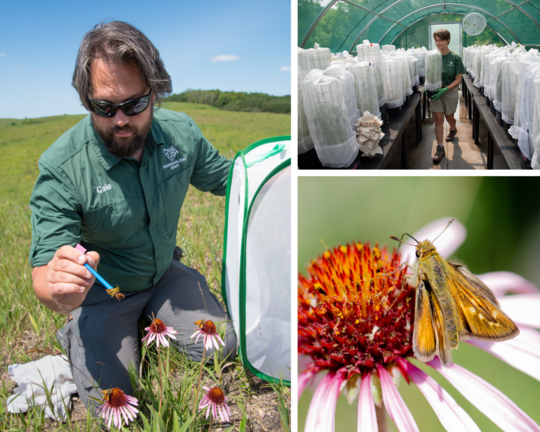 Left: Minnesota Zoo Biologist Cale Nodmeyer places a Dakota skipper butterfly on a coneflower using a paintbrush. Top right: Minnesota Zoo butterfly biologists raise Dakota skipper caterpillars in netted cages. Bottom right: A reintroduced Dakota skipper butterfly feeds on the nectar of a narrow-leaved purple coneflower at Glacial Lakes State Park. Photo credit: Deb Rose
|
|
Don't get caught on the phishing hook
Report suspicious emails with Outlook "report phishing" button
Phishing emails target all state employees, so it's likely you've seen a phishing email at one point in your inbox. Reporting these emails helps MNIT spot and stop phishing attacks before cybercriminals impact state systems. The sooner the MNIT Security Operations Center (SOC) is alerted to malicious email, the quicker they can respond.
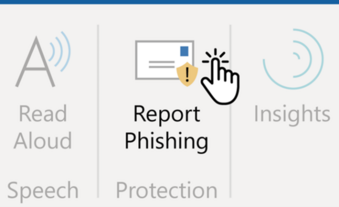
Report phishing from Outlook
You can easily report suspicious emails in Outlook using the "report phishing" button. The button can be found on the Outlook ribbon toward the right of the screen. To use the button (typically
on laptops and desktops):
- Highlight the suspicious email in your Outlook inbox.
- Select the "report phishing" button, found on the Outlook ribbon.
- In the pop-up window, select "report." This will move the suspicious email to your deleted items folder.
-
Note: the "report junk" option is different from the "report phishing" button.
|
Manually report phishing emails
|
When no "report phishing" button is displayed (typically on the Outlook mobile app):
- Highlight the suspicious email in your Outlook inbox or select the email to display it on a phone.
- Forward the email as an attachment (Ctrl + Alt + F, if using a keyboard) to reporting@state.mn.us.
- On a mobile device, click the vertical ellipsis (...) in the upper right. Choose "forward as attachment."
-
Note: the email has to be forwarded as an attachment, as just forwarding it will cause it to be rejected by the SOC.
|
|
 |
What do I do if I clicked a link or opened an attachment that might be suspicious?
Don't panic. Call the MNIT Service Desk at 651-297-1111 (24/7) to report a possible security incident and get help:
- Tell them you have a possible security incident and provide as much detail as possible. When did it happen? What actions did you take? What happened or what were you asked to do?
- Tell your manager or supervisor so they are aware of the situation.
For more information, check out these articles from MNIT Services:
Join the step challenge, support your well-being
 Starting July 31, join the step challenge to support your well-being and explore Minnesota! The virtual, 28-day "Tour de Minnesota" challenge will take participants through different parts of the state as increased step counts unlock different stages.
While this challenge is available to all state agencies, it almost seemed tailored for Minnesota DNR employees — participants will learn more about prairies, lakes and forests along the journey. Let's show our love for Minnesota's natural resources and embark on this challenge together!
When: July 31 to Aug. 27
Where: You can participate wherever you are and then submit your step activity using the Virgin Pulse platform.
Who: All benefit-eligible employees with a Virgin Pulse account can participate. Learn how to set up an account and review common data privacy questions on the Minnesota Management and Budget well-being program webpage.
How: Look for email invitations to join on July 24 and July 31, or mark your calendar and join the challenge when it's released on Virgin Pulse July 31. Want to form a team? Reach out to some colleagues now and make a plan. You have the option to convert a variety of activities into step counts, such as gardening, biking, yoga, or housework. Focus on what is fun and works for you.
Why: There are many benefits to moving more and participating in team activities. The Well-being Action Team invites you to focus on the mental health benefits of exercise, such as better sleep, more energy, improved mood, sharper memory and thinking, and improved resilience. Challenge participants will be rewarded 100 points toward the 300 points needed to earn a $70 reduced deductible next year if they track activity at least once a week for all the weeks of the challenge.
Questions? Watch for more details from MMB on July 24, or Laura Grunloh or any member of the Well-being Action Team can answer questions in the meantime.
Disability pride — what is it?
 By Jill Westberry, ADA Coordinator
Disability Pride Month in Minnesota began last year, when Gov. Tim Walz proclaimed July 2022 as Disability Pride Month in conjunction with celebrating the Americans with Disabilities Act of 1990, which was signed into law on July 26, 1990.
Disability pride might mean different things to different people. For some, disability pride comes from within, while for others, it might be more societally based or a combination thereof. You can read more about this in stories from the Minnesota Council on Disability and Twin Cities PBS.
Disability pride has a flag, created by Ann Magill and entered into the public domain in 2019. The flag was redesigned in 2021 with muted colors and straight stripes in response to feedback from those with visually-triggered disabilities. According to Wikipedia, the new flag comprises a number of different elements, each symbolizing different aspects of the disability experience:
-
All six "standard" flag colors: disability spans borders between states and nations.
-
Black field: mourning for victims of ableist violence and abuse.
-
Diagonal band: cutting across the walls and barriers that separate people with disabilities from society
-
Red stripe: physical disabilities
-
Gold stripe: neurodivergence
-
White stripe: invisible disabilities
-
Blue stripe: psychiatric disabilities
-
Green stripe: sensory disabilities
At the Minnesota DNR, we recognize the work and contributions of every member of the public and every employee with different abilities or that has a disability. Our agency has three core areas surrounding ADA and to support individuals with disabilities that we serve, including:
- Employment accessibility, managed by Jill Westberry
- Public accessibility, managed by Melinda Anderson
- Digital accessibility, managed by Rebecca Blomquist
The governor's proclamation acknowledges that "celebrating culture, community, and the ADA is only a starting point, and there remains significant room for progress toward full and equitable access and inclusion for Minnesotans with disabilities."
We have progressed over the years in increasing our agency's accessibility efforts across the three areas mentioned above. However, we also recognize it to be a continual work in progress. All of us are in this boat together and have a collective responsibility to ensure equitable and inclusive access in our respective areas, from ensuring PowerPoints are fully accessible to making sure reasonable accommodations are properly implemented. Let's make our agency a best practice!
If you have questions about any of the three agency accessibility areas, please reach out to any of the coordinators. If you have questions about ADA reasonable accommodation, please contact Title I ADA Coordinator Jill Westberry.

Heat, rain and wind extremes in Minnesota
 Daily high and low temperatures recorded from July 5-18, 1936 in Minneapolis.
By Kenny Blumenfeld, DNR Climatologist
In a state famous for climate extremes, these events represent the most extreme of them all:
Minnesota's worst heat wave on record: July 1936
Few Minnesotans can comprehend heat like this. Beginning July 5, 1936, the Twin Cities had 14 straight days with high temperatures of at least 90°F, including eight days at or above 100°F, five straight days of at least 105°F, and a maximum of 108°F. Temperatures never fell below 80°F for an entire week, and the low temperature on July 13 was a blistering 86°F. The heat gripped the entire state, with nine 100°F days in St. Cloud, eight in Cloquet, six in Grand Rapids, and even three in Duluth, which recorded a high of 106°F. Air conditioning didn't exist at the time and fans were scarce. With no way to cool off, the extraordinary heat killed about 900 Minnesotans.
Minnesota's largest known rainfall event: Aug. 18-20, 2007
Powerful, slow-moving and regenerating thunderstorms dropped 15.1 inches of rain in one day at Hokah, breaking the state's official all-time daily rainfall record by nearly 40%. A total of 54 volunteer observers from 16 different counties reported at least six inches of rain, and an unprecedented 15 separate observers reported storm totals of 10 inches or more. In Minnesota alone, the storm footprint was three times larger than that required to qualify as a "mega-rain," and the damage to towns, infrastructure and public lands in southern Minnesota from flooding, erosion, mudslides and sinkholes can still be detected more than 15 years later.
Minnesota's windiest day: Oct. 10, 1949
Picture a windy fall day. Now picture that same thing, but with skyscrapers swaying until their occupants become sick, boats tossed into piles on lakeshores, and people injured by flying projectiles and falling debris. These weren't from tornadoes or a severe thunderstorm, but extraordinary regional winds, following explosive intensification of a low-pressure area to the northwest. Wind gusts reached 89 mph at the Twin Cities airport, and 100 mph in Rochester. Power poles were snapped across the state, shingles were peeled from roofs, more than 100 Minnesotans were injured and four were killed.
|
|
Eldercare support available from EAP
 The Employee Assistance Program offers comprehensive assistance to help identify and navigate eldercare services such as selecting assisted living, legal and financial services, adult daycare, long-term care, hospice care, home care, and help completing applications for assistance. EAP is available to all employees, regardless of benefit status.
How it works: the EAP program has staff who are eldercare specialists. Call the EAP Work/Life Services Program Line at 800-657-3719 and let them know you're interested in eldercare services. They will arrange an eldercare specialist to contact you and discuss your needs.
After the intake call, it takes two to three days for EAP to get the information. After that time, the specialist will email you the results. For example, if you requested information on memory care facilities within an hour of Rochester, you would receive a list of facilities along with contract information and any other specifics requested, like if the facilities were taking on new clients. The specialist will follow-up and make sure you received the information and answer any remaining questions.
EAP in use: Jeff Weis, a Well-being Action Team member and hydrologist, used EAP to prepare this article and better understand the services available.
"My mother has been in the memory care unit of an assisted living facility for the past year," Weiss said. "The process of getting her there was not simple or easy. I wish we would have known about the eldercare services provided by EAP when we were going through the process of locating a facility that met her needs. The amount of documentation regarding financial resources and medical information can seem overwhelming and the entire process can take months to complete. The eldercare specialists with the EAP Program would have been a great help to us in navigating the application process. I encourage anyone going through this to give EAP a call. It is a lot harder to do things without help, and this help is here for you.”
Legal services: Legal advice is a common need for the elderly and their caregivers. EAP can put you in contact with an eldercare attorney. Attorneys can help you with financial matters associated with affording care, completing applications for Veterans’ Aid, creating wills and trusts, and arranging a family member receive payment for providing care. The EAP legal service benefit includes one 30-minute session per issue, per year and a 25% discount on the retainer fee after the 30 minutes.
Financial counseling: The EAP financial counseling benefit also includes one 30-minute session per issue, per year. This can be a helpful benefit to help establish power of attorney. Both legal and financial counseling services also offer free review of six pages of legal or financial paperwork per issue.
Additional services: A common need for the elderly is transportation to medical appointments. EAP can help identify transportation options specific to your location and needs.
During the pandemic, many people were isolated from their families for extended periods of time. This created an increased need for mental health support. EAP can provide connections to resources related to mental health.
Benefits for dependents and household: EAP services are available to dependents and others in your household. The employee, dependents, and household members can call and receive guidance and support coordinating eldercare for a family member or for other EAP services.
For more information:
Fleet recognized for sustainability efforts
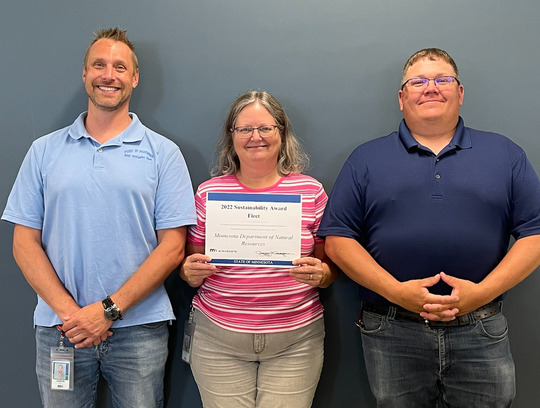 The Minnesota DNR fleet team was recognized by the enterprise for showing significant progress and innovation toward meeting sustainability goals in reducing fleet fossil fuel consumption.
The Minnesota DNR's goal was a 30% reduction of fossil fuels used by fleet vehicles by 2027 relative to a 2017 adjusted baseline. In 2022, the Minnesota DNR used 908,272 gallons of fossil fuels — a 27% reduction from baseline.
To reach this, the Minnesota DNR uses a hierarchy approach to look at electric vehicles and equipment options first, followed by hybrids, then alternative or cleaner burning fuels, and then gas or diesel equipment if necessary.
To sustain the trend, the focus will be on replacing equipment with the lowest possible fossil fuel consumption, supporting the use of E85 and biodiesel, and pushing the envelope toward electric vehicles and alternative fuel use as much as possible.
Pool vehicle reminders
Field season is in full swing and many Minnesota DNR staff are traveling frequently for work. Fleet vehicles should be the first option for travel whenever available because they are the most economical and often the most sustainable option for our agency. Personal vehicle use and reimbursement should be limited to situations when Minnesota DNR vehicles are not available.
There are 13 pool vehicles at Central Office and more than 50 pool vehicles at co-located sites across the state. Please remember that these vehicles are shared and should be ready for the next user by following these steps:
- Fill fuel if the tank is less than half full.
- Dispose of any trash in the vehicle.
- If dirty (interior and/or exterior), please wash the vehicle and vacuum the inside.
- Please use a car wash located at a fueling station that accepts WEX for payment.
- When using the WEX card, your PIN is the last 6 digits of your employee ID number.
- NOTE: The Mister Car Wash (formerly the Downtowner) on East 7th in St. Paul does not accept the WEX card or p-card.
- At the end of your trip, please make sure to complete all required fields in the Monthly Use Report (MUR) for each trip, and write legibly:
- Ending meter
- FinDeptID
- Trip purpose
- First and last name
- Please report any issues with pool vehicles to Fleet and Materials Manager Aaron Cisewski.
 What lies beneath
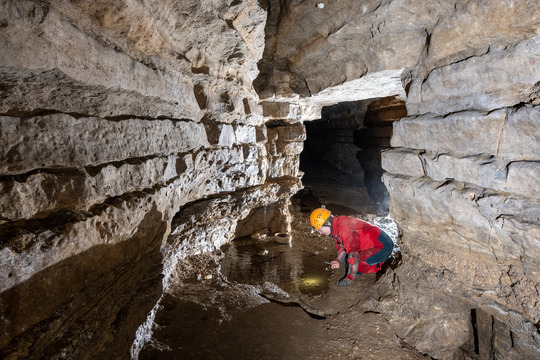 Cave Manager Dawn Ryan scans a surface pool for invertebrates at Mystery Cave.
By Carolyn Howell, MCV intern
Whether hidden in the backwoods or right beneath our feet, there's always something to discover in the great outdoors. Case in point: The current issue of the Minnesota Conservation Volunteer has an article set at Forestville/Mystery Cave State Park in southeastern Minnesota, where microscopic cave-dwelling critters are an odd representative of Minnesota's wild creatures. Virtually unnoticed among the curiously shaped stalagmites and stalactites that pique the interest of summer visitors, these invertebrates have lived a nearly invisible existence — until now. When Cave Manager Dawn Ryan commissioned species surveys of cave wildlife, researchers documented several organisms that had never been recorded in the area and may be unique to this northern, glacial-age cave. The new finds will help scientists investigate the mysteries of subterranean ecosystem interactions and explore how cave species adapt to changing environments.
Minnesota Conservation Volunteer is the magazine of the DNR. Supported by reader donations, its mission is to encourage conservation and sustainable use of Minnesota’s natural resources. For more info, visit mndnr.gov/MCV or subscribe.
|
|
Breakout rooms participant shuffle feature coming to Teams
A breakout room participant shuffle feature, coming soon to Microsoft Teams, will allow the capability to randomly assign participants to rooms after rooms are created. Participants can be randomly reassigned both prior to the meeting or during the live meeting. Shuffling can be applied to all participants or only to unassigned participants, re-distributing them evenly to existing rooms.
Meeting organizers, co-organizers or breakout room managers will be able to use the new capabilities when assigning participants to breakout rooms, both prior to meetings and during the meetings.
The feature will be available in August.
Kudos from Minnesotans
"I just read in the Star Tribune about (the library parks pass) program. Minnesota has wonderful state parks and it's exciting that this program is expanding access! I would be happy to support this program. Maybe something like where I could buy a pass to be donated to the program, as in 'pay it forward?' In any case, good work by (the) DNR!"
— Chris Amley
 Photo credit: Bill Weiss, who got several tattoos inspired by Maplewood State Park.
 |
|
Some people love Minnesota's natural resources and public lands so much, they've decided to get them permanently inked — is there any better kudos?
For National Tattoo Day on July 17, the Minnesota DNR social channels had a post asking to see Minnesotans' outdoor-themed tattoos.
The Facebook post alone had more than 90 comments, filled with tattoos of Lake Superior, maple leaves, pollinators, loons, Big Bog, rivers, the Boundary Waters Canoe Area Wilderness, Tettegouche State Park, ice fishing, the northern lights, ferns, fish, and more.
|
Accounts Payable reminders
 Invoices
An important upcoming deadline for invoices:
-
July 28: final day for payment of Fiscal Year 2023 (FY23) invoices referencing a BPM or APK.
Do not close out a FY23 purchase order until all vouchers for that PO have been verified as being fully paid out.
Utility invoices: for Accounts Payable to properly sort submitted utility invoices for timely payment, follow the naming convention for utility invoices as outlined in the Submitting Documents to Accounts Payable and File Naming Conventions document.
For utility or energy billings that occur monthly, use the account number followed by the statement date (include dashes) as the invoice number. If no statement date is printed on the utility bill, use the service end date as the statement date. For example:
- 02012023_56789 01-31-2023_0000201301 OR
- 02012023_56789 01-31-2023_XCEL ENERGY OR
- 02012023_56789 01-31-2023_0000201301 util
Utility invoices are only recurring monthly bills for electric, gas, and water usage expenses. Trash bills are not considered a utility for energy tracking purposes.
Employee business expenses
For all remaining FY23 business expenses, follow the memo instructions for completing and submitting the Fiscal Year End Late Business Expense Memo.
For all Fiscal Year 2024 (FY24) business expenses, submit the completed business expense form to the Accounts Payable email.
Purchasing cards
Review the P-Card packet to ensure all forms have been included and are in the correct order:
- Cardholder Purchasing Log
- Sales Tax Not Paid on Purchasing Card
- Reimbursement Sheet
- U.S. Bank Statement
- Original receipts and packing slips (in order listed on statement)
- Pertinent documents such as: Special Expense Form, Out-of-State Travel Form (with agenda), Statement of No Receipt
Grand Slamphibians no. 1... at ties
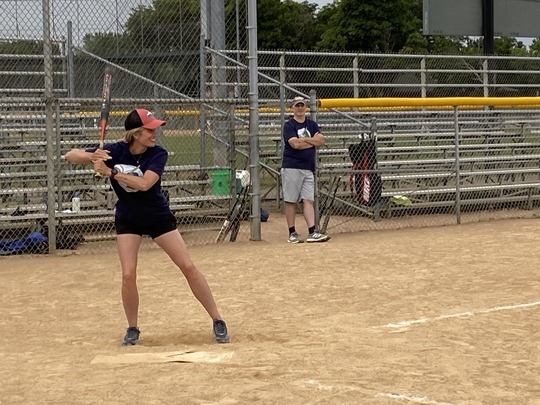 On July 11, the Minnesota DNR's Grand Slamphibians softball team pulled in another win. It was the best game of the year (so far), with everything working well in the field, at the plate, on the base paths, and on the mound. The Minnesota Pollution Control Agency team was shut out for most of the game and once the Slamphibians took the lead, they never gave it up.
On July 18, the Slamphibians tied the Minnesota Department of Agriculture Emerald Ash Bashers in an eight inning game. The two teams swapped leads all game, and it was clear they could have continued for several dozen additional innings and well into the weekend, if necessary, without a clear winner. Both teams agreed to stop before it got to that point and accept each other as equals — for now. Final score was 6-6.
The Slamphibians continue to keep the league running by lending players to others teams as substitutes and spirits high with good energy and fun walk-up songs.
The next few games will have the Grand Slamphibians face the Minnesota Department of Health and Department of Human Services Explosive D (another chance to ask about the name) on July 25 at 5:45 p.m., and the Office of Higher Education and Department of Public Safety Base Invaders at 5:45 p.m. The games are held at the Dunning Sports Complex softball fields in St. Paul, and the team welcomes fans.

Bat and Wildlife Intern Maren Honsey
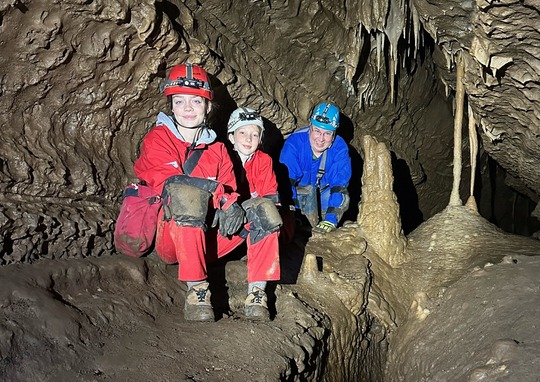
|
|
Building better futures for bats
By Anna Himango, OCO Intern
The Minnesota DNR is in Bat and Wildlife Intern Maren Honsey’s blood.
Although her background in environmental work is limited, Honsey is familiar with the DNR through her family members, former employees Martin Torgerson Sr., Martin Torgerson Jr., and Becky Torgerson. She is also passionate about being and working outside — her former role as a summer camp counselor-in-training at Eagle Bluff only stoked the fire.
Honsey filled a variety of student leadership positions at Stewartville High School prior to her graduation in 2022. From being captain of the tennis, golf, and speech teams to being on the executive board of a band, Honsey has a diverse array of talents. In her senior year of high school, Honsey and her speech team went to state, where she placed eighth in the "Extemporaneous Reading" category. Her leadership and public speaking skills have been invaluable in her work so far as the bat and wildlife intern at Forestville/Mystery Cave State Park.
Honsey is currently a sophomore at the University of Minnesota Twin Cities College of Food, Agricultural and Natural Resource Sciences, where she is part of the Land Grant Legacy Scholars Program. She is majoring in environmental sciences, policy and management on the conservation and resource management track.
“I’m not concrete on a career path right now, but a position in the DNR is something that I am striving towards,” Honsey said. “I’ve loved my experience as an intern here at Mystery Cave State Park so far.”
Over the course of her internship, Honsey has been on a day-long caving trip, trained in cave surveying, monitored new rocket-style bat boxes, done work that might contribute to combating white-nose syndrome, and gained a love for bats.
|
 Hometown:
Stewartville
Work location:
Forestville/Mystery Cave State Park
Joined the DNR:
April 2023
Job title:
Bat and wildlife intern
Education:
Bachelor of Arts in Environmental Science, Management and Policy on the Conservation and Resource Management Track at the University of Minnesota, Twin Cities (in progress)
Hobbies:
Playing the drums, public speaking and listening to a wide variety of music
Something that might surprise your colleagues:
“I have a totally irrational fear of fish.”
|
|
|
As part of a statewide bat survey to learn more about artificial bat roost efficacy, Honsey notes the number of bat individuals and species, as well as time and temperature every day. She is developing an interpretive wayside panel and programs about bats, bat boxes, and WNS. Honsey said she has been enjoying her interactions with the public already, talking about bats and answering questions.
Honsey is looking forward to the remainder of her internship, as well as all the new skills and knowledge she will proudly walk away with at the end of the summer.
|
|

Learning in nature
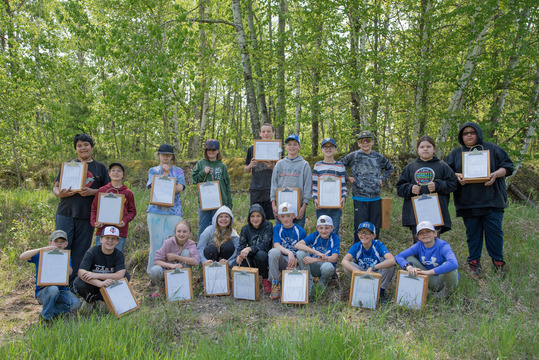 Photo credit: Deb Rose
A group of fifth graders at a McGregor school hold lap desks made by volunteers and donated to the school for use in the school forest. The desks are handmade and make the students' lives a lot easier when learning in the forest.
|
|
Submit to Spotlight
Send Spotlight articles and photos to newsletter.dnr@state.mn.us.
Next Spotlight is scheduled for Aug. 4. Deadline for content is Aug. 2.
|
|
|
|
|